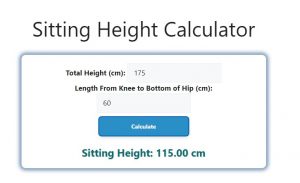About Sitting Height Calculator (Formula)
The sitting height is an important anthropometric measurement that helps in various fields, including ergonomics, healthcare, and sports science. It refers to the vertical distance from the sitting surface to the top of the head. Knowing your sitting height can be useful for designing comfortable seating arrangements, optimizing workstations, and assessing growth in children. The Sitting Height Calculator provides a simple way to compute this measurement, making it accessible for personal use or professional applications. In this article, we will explain the formula, how to use the calculator, provide examples, and address common questions related to sitting height.
Formula
The formula for calculating sitting height (SH) is as follows: SH = TH – KTH, where SH represents sitting height, TH is the total height, and KTH is the knee height. This formula allows you to determine your sitting height by subtracting knee height from total height.
How to Use
Using the Sitting Height Calculator is easy and can be done in a few steps:
- Measure Total Height (TH): Stand straight against a wall and measure your total height from the floor to the top of your head.
- Measure Knee Height (KTH): Sit on a flat surface with your feet flat on the ground, and measure the height from the sitting surface to the top of your knee.
- Input Values: Enter the measured values for total height and knee height into the calculator.
- Calculate Sitting Height: Click the “Calculate” button to determine your sitting height.
- Review Results: The calculator will provide your sitting height, which you can use for further assessments or adjustments.
Example
Let’s consider an example where you want to calculate the sitting height of a person with the following measurements:
- Total Height (TH): 175 cm
- Knee Height (KTH): 60 cm
Using the formula:
SH = TH – KTH
Substituting the values:
SH = 175 – 60
SH = 115 cm
In this example, the sitting height is 115 centimeters.

FAQs
- What is sitting height?
Sitting height is the distance from the sitting surface to the top of the head when seated. - Why is sitting height important?
It helps in ergonomic design, health assessments, and understanding body proportions. - How do I measure total height?
Stand straight against a wall and use a measuring tape or ruler to measure from the floor to the top of your head. - How do I measure knee height?
Sit on a flat surface with your feet flat on the ground and measure the height from the surface to the top of your knee. - Can I use this calculator for children?
Yes, the calculator can be used for individuals of all ages, including children, to assess growth and proportions. - What factors can affect sitting height?
Factors include age, gender, and body composition, as well as specific measurements like total height and knee height. - Is sitting height the same for everyone?
No, sitting height varies among individuals based on their body proportions. - What is the average sitting height for adults?
Average sitting height can vary by population, but it generally ranges between 80 cm to 100 cm for adults. - How does sitting height relate to ergonomics?
Understanding sitting height helps in designing furniture and workspaces that accommodate users comfortably. - Can I use the calculator for specific ergonomic assessments?
Yes, the calculator is useful for ergonomic evaluations to ensure proper seating and workstation setup. - How often should I measure sitting height?
It’s a good idea to measure sitting height during growth spurts or changes in health, especially for children. - Does sitting height change with age?
Sitting height generally remains stable in adulthood but can change due to posture or health issues. - What is the significance of knee height in this calculation?
Knee height is a crucial measurement that reflects lower body proportions and helps determine sitting height. - Can I measure sitting height without a calculator?
Yes, you can calculate sitting height manually using the formula, but the calculator simplifies the process. - How can sitting height affect my comfort in a chair?
A chair designed for your sitting height ensures proper support for your back and legs, enhancing comfort. - What tools do I need to measure height and knee height?
A measuring tape or ruler is typically sufficient to measure both total height and knee height accurately. - Are there standards for sitting height in workplace design?
Yes, ergonomic guidelines often include recommendations for seating dimensions based on average sitting height. - What role does sitting height play in sports science?
Sitting height is used in sports science to assess athletes’ body proportions and optimize performance. - How can I improve my sitting posture?
Maintaining proper sitting height and using ergonomic furniture can significantly improve your sitting posture. - Where can I find more information about body measurements?
Health and fitness websites, anthropometric studies, and ergonomic resources provide valuable information on body measurements.
Conclusion
The Sitting Height Calculator is a practical tool for anyone looking to measure and understand their sitting height. By using the provided formula and following the steps outlined in this article, individuals can easily determine their sitting height, which is essential for ergonomic assessments, health evaluations, and overall comfort. Understanding how sitting height impacts daily activities can lead to improved well-being and a better quality of life. Whether for personal use or professional applications, the Sitting Height Calculator is a valuable resource for anyone interested in optimizing their seating arrangements and posture.